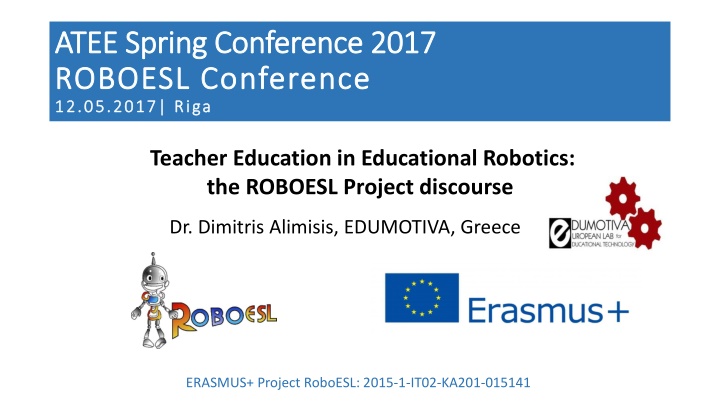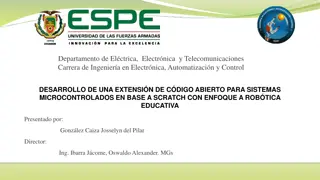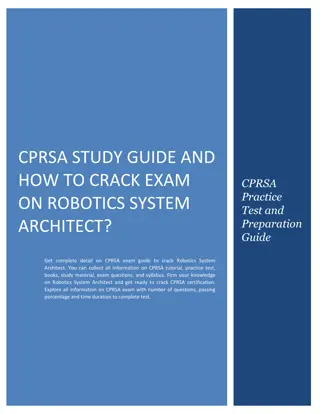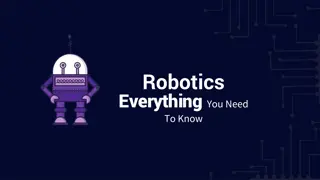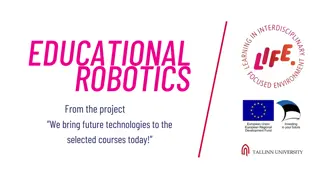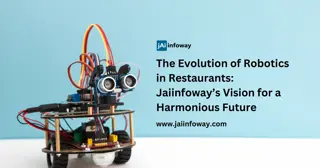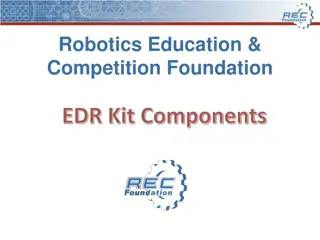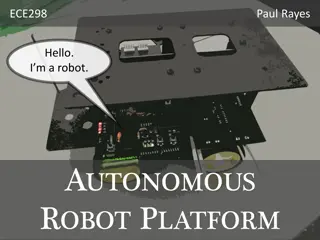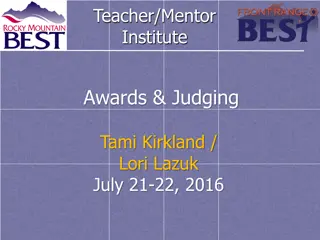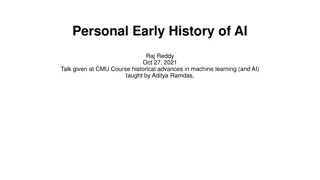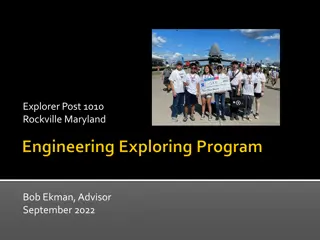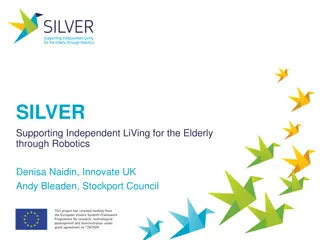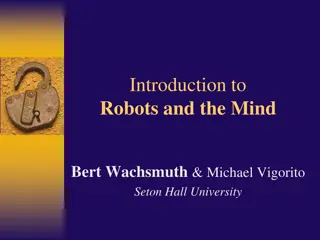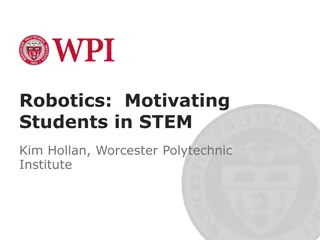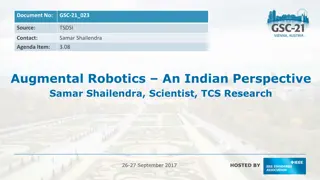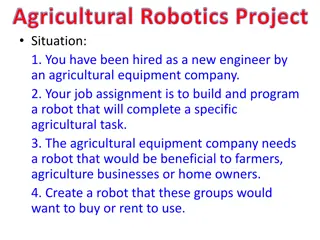Enhancing Education through Robotics: The ROBOESL Project
Explored in this content is the innovative ROBOESL Project, focused on utilizing educational robotics to support at-risk students in developing creativity, improving self-esteem, and fostering a positive attitude towards education. The consortium comprising partners from Italy, Greece, and Latvia collaborates to deliver intellectual outputs including open educational resources, teacher training curricula, and validation reports. Teacher training courses are conducted in Athens, Riga, and Genoa, while robotics activities engage students in Athens, Piraeus, Genoa, and Valmiera.
Download Presentation

Please find below an Image/Link to download the presentation.
The content on the website is provided AS IS for your information and personal use only. It may not be sold, licensed, or shared on other websites without obtaining consent from the author.If you encounter any issues during the download, it is possible that the publisher has removed the file from their server.
You are allowed to download the files provided on this website for personal or commercial use, subject to the condition that they are used lawfully. All files are the property of their respective owners.
The content on the website is provided AS IS for your information and personal use only. It may not be sold, licensed, or shared on other websites without obtaining consent from the author.
E N D
Presentation Transcript
ATEE Spring Conference 2017 ATEE Spring Conference 2017 ROBOESL Conference ROBOESL Conference 12.05.2017| Riga 12.05.2017| Riga Teacher Education in Educational Robotics: the ROBOESL Project discourse Dr. Dimitris Alimisis, EDUMOTIVA, Greece ERASMUS+ Project RoboESL: 2015-1-IT02-KA201-015141
The consortium consists of 7 partners Liceo E. Fermi (coordinator) (Italy) Scuola di Robotica (Italy) Universit degli studi di Padova (Italy) Edumotiva- European Lab for Educational Technology (Greece) 6EK A PEIRAIA (Greece) 7th Secondary Education School Committee of Athens Municipality (Greece) Valmieras 5.vidusskola (Latvia) Latvijas Universitate (Latvia)
The The RoboESL RoboESL project To highlight the potential of educational robotics for schools in order to help children at risk of failure or Early School Leaving to practice and develop children s creativity skills To raise self-esteem, To motivate interest in schooling, To encourage towards staying at school project aims aims ERASMUS+ Project RoboESL: 2015-1-IT02-KA201-015141
3 main intellectual outputs 3 main intellectual outputs Output 1 Open Educational Resources for 10 exemplary interdisciplinary robotics projects freely available for teachers and students Output 2 A curriculum for teacher training course to enhance educational robotics uptake in teaching and learning Output 3 Validation report on the impact of the robotics projects on the selected students achievements and attitudes ERASMUS+ Project RoboESL: 2015-1-IT02-KA201-015141
ROBOESL for teachers ROBOESL for teachers 1st teacher training course in Athens, GR 2nd teacher training course in Riga, LT 3rd teacher training course in Genoa, IT ERASMUS+ Project RoboESL: 2015-1-IT02-KA201-015141
ROBOESL for school students ROBOESL for school students Robotics activities in schools in Athens and Piraeus, GR Genoa, IT Valmiera, LV
Changing teachers role Changing teacher s role ER methodology requires that learners themselves are active with a high need to explore, to design, to create and to share experiences and ideas Hence, teachers in ROBOESL training paradigm are encouraged to change their role to facilitators and enablers They learn to design and implement relative simple robotic projects in the context of scenarios from everyday life using robotics kits
The role of the teacher: 3 not The role of the teacher: 3 not not to ensure that students solve the problems and run projects in the way anticipated by the teacher nor just follow steps to arrive at a pre-defined result Teacher does not function as an intellectual authority that transfers ready knowledge to students
The role of the teacher The role of the teacher acts as an organizer, coordinator and facilitator of the learning process. organizes the learning environment, raises the tasks / problems to be solved offers resources supports students engagement in the ROBOESL interdisciplinary projects discreetly helps where and when necessary encourages students to try out different ideas and solutions and to work in teams organizes the evaluation of the activity in collaboration with the students. ensures a playful, open, non-judgmental, and collaborative classroom environment that fosters creativity and collaboration
Educational methodology constructivist/constructionist pedagogy (Piaget, Papert) project-based learning approach active reflection upon the task
Educational methodology experiential learning and learning by making instead of giving step-by-step instructions, teachers/learners are advised to try and figure out how to do it themselves
The curriculum: aim The curriculum: aim enabling teachers to master the technical and pedagogical skills to become able to develop their own robotics activities Learn to use innovative, student-centered and constructivist pedagogical approaches focus on preventing School Failure and Early School Leaving.
Main objectives To promote learning through interaction of the trainee with the robotics technologies To support self-directed action allowing trainees to learn independently. To support the development of real training scenarios encouraging the engagement of the trainee in authentic problem solving . To adjust training to trainee s needs and interests by offering training tasks with options to advance to different levels of difficulty Finally to provide methodology and tools for the overall evaluation of the training program.
content content pedagogical approaches to cope with school failure/ESL robotics-based learning methodologies inspired from constructivism and project-based learning principles training activities for familiarisation with educational robotics using robotics kits and software guidelines for using resources Worksheets for exemplary robotics-based learning activities evaluation guidelines and tools (to be used in O3) for validating the impact of robotics-based learning activities on the prevention of school failure/ESL validation criteria and tools for validating the impact of the curriculum on the participant teachers.
Training activity 1 Training activity 1 3 different teaching practices Three teachers introduce for first time robotics in their class. Teacher A starts with a presentation of the Lego Mindstorms kit together with projection of slides that show in detail the content of the kit and demonstrates in front of the class how to make a first robotic construction Teacher B divides the class in groups of 3-4 students, provides a Lego Mindstorms kit for each group and a handbook with step by step instructions to make a robotic car. Teacher C divides the class in groups of 3-4 students, provides a Lego Mindstorms kit for each group, then encourages and help students to explore the content of the kit, and invite them to try out a first robotic construction of their own choice
Scenario Scenario Imagine a train travelling in a straight rail. The distance between two successive stations is the same. A train runs over this rail travelling at constant speed on the track between two stations, and stops for some time at each station before leaving again. When it reaches the end of line, it waits a bit longer and then it comes back in reverse way towards the starting station. Make a robot to emulate the train on the monorail. ..
Discuss within your group the scenario How can you make the robot to follow the sides of a regular polygon of 6 sides and to collect some data, namely the color code of a piece of paper or tape put on each vertex reporting the maximum value?
Thinking before acting Thinking before acting Form and write down a methodology to solve this problem
Making a mock up Draw the rail with a straight line and some stations in the same distance on a long sheet of paper and put it on the table or on the floor or put directly on the table or on the floor some short pieces of tape in same distance to stand for the stations.
Explorations Examine how the block Move Steering works Exploration: Set the duration in seconds. How many seconds the train needs to travel from one station to the next one? Write your answer here . How did you find this answer?
Only the necessary guidance Task 7. Here comes the sound! Experiment with the sound block to make the robot play sounds. Duration Type: Play note Wait for completion Volume Note textual code
Half Half- -baked solutions baked solutions Below you can find a half-baked solution. This means that some parts are missing and some values needs to be adjusted. Can you complete the algorithmic solution?
Not revealing answers Now make your train to travel all the line stopping in each station for some seconds. Can you think of a command that would help to make the programming task easier? Write your idea here
Or revealing solutions at the right moment Here is the Loop block to repeat the motion as many times as you wish. You can insert your blocks inside one Loop block. Make your train to travel all the line using the Loop block.
Experimentations Experiment how to make the robot turn 90 degrees
What if experimentations Task 8. Check what will happen if you integrate the advanced math block among the two blocks that you have already built. What happens when a equals to b? . What happens when a is bigger than b? .. What happens when b is bigger than a? ..
Going beyond trial and error strategies Going beyond trial and error strategies What happens if the distance between the stations changes? Working again with the trial and error method takes time! Let s use some maths to make the train to travel the distance between the stations.
Trying out a scientific method Remember! When the wheel rotates 360 degrees (1 full rotation) the robot travels 2 R distance (R=radius of the wheel). Write here your solution .. Check your solution, does it work? 2 R
Task 8. Study in the following sketch how the tribot turns around the stopped wheel. Can you think of a mathematical reasoning underpinning the relation between the rotations of the motor and the turning angle of the tribot? d
Embodiment Embodiment embodied cognition embodied cognition How to instruct the robot to move in a triangle? Play the robot with your own body using your own senses
Inductive method Years ago S.Papert formulated the Turtle total trip theorem: the turtle will draw a closed figure with n sides when the sum of the angles turned is 360. What is the angle to turn each time to draw a triangle? If you get it right the turtle will draw a closed triangle. Try it with your tribot. What is the angle to turn each time to draw a square? Confirm this with your tribot. Now what is the angle to turn each time to draw a hexagon? Confirm again with your tribot
Encouragement Try again and again your parking project until you succeed!
Encouraging team work Encouraging team work Can you think of another solution that would give a more precise behavior? Discuss with your partners and briefly document your ideas. ---------------------------------------------------------------------------------------------- -------------------------------------------------------------------------------------------- -------------------------------------------------------------------------------------------- -------------------------------------------------------------------------------------------- -------------------------------------------------------------------------------------------- -------------------------------------------------------------------------------------------- -------------------------------------------------------------
Encouraging sharing of ideas Encouraging sharing of ideas Task . Start programming your robot to skip just one obstacle. Repeat your trials until you succeed. Describe here your programming solution in your own words for further discussion.
Encouraging reflections Encouraging reflections Task. Prepare with your group a short presentation of your final solutions in the class, reflect with critical mind on your work, on comments and evaluation. After that write down your personal experiences from this project in your diary.
The curriculum will become freely available on line with open access www.roboesl.eu for more www.edumotiva.eu info@edumotiva.eu
